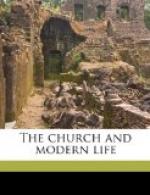It is not a churchman, or a theologian, it is Mr. John Fiske, one of the foremost scientific investigators, who has said of religion: “None can deny that it is the largest and most ubiquitous fact connected with the existence of mankind upon the earth."[1]
About the size of the fact there is no disputing, but how shall we explain it? Where did it come from?
The scientific people have puzzled their heads not a little over the question where the life on this planet came from. They cannot make up their minds to say that it came from non-living matter; and some of them have ventured a guess that the first germs might have been brought by a meteorite from some distant planet. That, however, only pushes the mystery one step further back: how did it come to be on that distant planet?
The origin of religion has furnished a similar puzzle to these investigators. There are those among them who assume that religion is an invention of crafty men who find it a means of obtaining ascendency over their fellows. That it is all imposture—the product of priestcraft—is the theory of some small philosophers. Such being the case, they expect that the progress of knowledge will cause it to disappear.
To others it seems probable that religious ideas may have originated in the phenomena of dreams. In the visions of the night those who have passed out of life reappear; this gives room for the belief that they are still in existence, and suggests that there may be another world whose inhabitants exert an important influence over the affairs of this world. According to this ghost theory, religion is all an illusion.
Such crude explanations are, however, not much credited in these days by thoughtful men. It is easy to see that the foundations of religion are deeply laid in human nature. Aristotle told a great truth, many centuries ago, when he said that man is a political animal. That is to say, there is a political instinct in him which causes him to organize political societies and make laws; he is a state builder in the same way that the beaver is a dam builder, or the oriole is a nest builder, or the bee is a comb builder.
With equal truth we may say that man is a religious animal. The impulse that causes him to worship, to trust, to pray, is as much a part of his constitution as is the homing instinct of the pigeon. This natural instinct is, however, reinforced by the operation of his reason. Feeling is deeper than thought; we are moved by many impulses before we frame any theories. But the normal human being sooner or later begins to try to explain things; his reason begins to work upon the objects that he sees and the feelings that he experiences. And it is not long before something like what Charbonnel describes must take place in every human soul:—
“Every man has within him a sense of utter dependence. His mind is irresistibly preoccupied by the idea of a Power, lost in the immensity of time and space, which, from the depths of some dark mystery, governs the world. This power, at first, seems to him to manifest itself in the phenomena of nature, whose grandeur surpasses the power or even the comprehension of mankind."[2]




